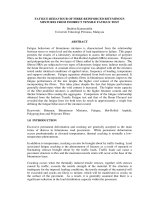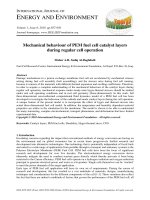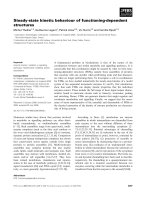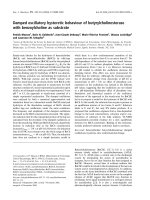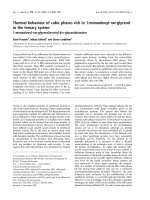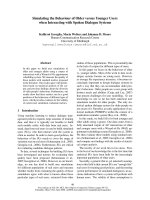static behaviour of curved girders name of lecturer pekka pulkkinen presentation 18.03.2004 helsinki university of technology
Bạn đang xem bản rút gọn của tài liệu. Xem và tải ngay bản đầy đủ của tài liệu tại đây (3.73 MB, 27 trang )
STATIC BEHAVIOUR OF CURVED GIRDERS
Name of lecturer Pekka Pulkkinen
Presentation 18.03.2004
Helsinki University of Technology (HUT) SEMINAR
Spring 2004
Bridge Engineering (BE) Rak-11.163 Licentiate Seminar In Bridge Engineering
Name of lecturer: Pekka Pulkkinen
STATIC BEHAVIOR OF CURVED GIRDERS 3
ABSTRACT 3
INTRODUCTION 3
1. TORSIONAL WARPING STRESS 3
1.1 Denition of Torsional Parameter κ 3
1.2 Values of parameter κ for actual bridges 4
1.3 Relationships between the stress ratio σ
ω
/σ
b
and κ. 7
1.3 The critical torsional parameter κ
cr
9
1.4 Approximation of σ
ω
and in curved box girders. 10
2. DISTORSIONAL WARPING STRESS 12
2.1 Parameters of distortion. 13
2.2 Variation in the distortional warping stresses due to various parameters 14
2.3 Rigidity of intermediate diaphragms. 17
2.4 Design formula for curved box girders 19
3. DEFLECTION OF CURVED GIRDER BRIDGES 22
3.1 Approximate solution for deection. 22
3.2 Denition of the deection increment factor ν. 24
3.3. Values of γ for actual bridges 24
3.4 Variation in deection due to γ and Φ 25
4. SUMMARY AND CONCLUSION 26
Page 3
STATIC BEHAVIOR OF CURVED GIRDERS
ABSTRACT
This is the seminar presentation of the Seminar in Structural Engineering in spring 2004.
The course is arranged in the Helsinki University of Technology by Laboratory of Bridge
Engineering, Laboratory of Structural Mechanics and Steel Structures and is for under- and
postgraduate students.
In this paper the static behaviour of curved bridges is claried by investigating actual bridge
cases. Basis of torsional warping is shortly explained and the behaviour of three types of
cross sections are studied and compared. The effects of diaphragm spacing, central angle
and cross sectional quantities to distorsional warping stresses are presented with four typical
box girder bridges. Based on the examinations practical design guidelines are derived and
explained.
Finally the theory of deection of curved girder bridge is formulated. Also in this part
monobox, twin-box and multiple I-girders are compared and practical design instructions are
presented.
INTRODUCTION
Curved bridges are often constructed in multi-level junctions. Analysing of torsional stresses
of the girders is the most challenging and interesting part of the design process.
In the design of curved girder bridges, the engineer is faced with a complex stress situation,
since these types of bridges are subjected to both bending and torsional forces. In general,
the torsional forces consists of two parts, i.e., St. Venant’s and warping. Thus the procedure
for determining the induced stresses of a curved girder is difcult.
1. TORSIONAL WARPING STRESS
In order to clarify the magnitude of the torsional warping stress, the following preliminary
analysis is conducted.
1.1 Denition of Torsional Parameter κ
The coverning differential equation for the twisting angle θ of a curved beam subjected to
torque m
T
is
(1)
Page 4
The bimoment M
ω
is given by the well-known formula
(2)
In this formula one should note the analogy between warping and bending.
The differential equation (1) can be rewritten with respect to the bimoment as
(3)
where the parameter α is given by
(4)
This parameter can be nondimensionalized by multiplying by the central angle of curved
girder Φ, which yields
(5)
1.2 Values of parameter κ for actual bridges
In the following torsional parameters κ for various curved girder bridges with cross sections
as illustrated in Fig.1 were investigated by using the actual dimensions of the bridges. The
investigated cross sections are open multi-I-girder, twin-box-girder and monobox girder.
Figure 1. Investigated curved girder bridges: a) multiple-I girder, (b) twin-box girder, and (c)
monobox girder.
In evaluation the torsional constant K and warping constant I
ω
of bridges modelled as a
single girder, exact solutions may be applied. In addition to these techniques, approximate
and simple formulas can be applied for multi-I-girder and twin-box-girder bridges. First, an
Page 5
arbitrary point B is chosen as the
origin, as shown In Fig. 2.
Figure 2. Estimation of shear
center S for curved multiple-I-
girder bridge.
If we assume horizontal
and vertical axes ξ and η,
respectively, the location of the
shear center S for the multiple
girder bridge, idealized as a
single unit, can be determined
from the equations.
(6a)
(6b)
where ζ
i
,η
i
= horizontal and vertical distances, respectively, between centroid
C
i
of ith girder and point B
I
x,i
,I
Y,i
= moments of inertia of ith girder with respect to the centroidal X
i
And Y
i
axes respectively
The torsional and warping constants can be approximated as
(7)
(8)
where K
i
= torsional constant of ith girder
I
ω,i
= warping constant with respect to S
i
of ith girder
e
,xi
,e
Y,i
= horizontal center S
i
of ith girder and shear center S of the system
Also the centroid C for the system of curved beams can be determined from
Page 6
(9a)
(9b)
where A
i
is the cross-sectional area of the ith girder. The corresponding moment and
product of inertia, which will be required in the stress analysis, can approximated by
(10a)
(10b)
(10c)
where I
X,i
,I
Y,i
= geometric moments of inertia with respect to X
i
and Y
i
axes,
respectively, of ith girder
I
XY,i
= product in inertia with respect co C
i
of ith girder
e
X,i
,e
Y,i
= horizontal and vertical distances respectively,between C
i
and C
By applying these approximate formulas to actual bridges, the interrelationship between κ
and Φ has been determined; see the results in Fig. 3.
Examination of the trends in Fig. 3 indicates
that Φ is not important and that the
parameter κ will have the following ranges:
κ = 0,5-3 multiple-I girder
(11a)
κ = 3-10 twin box
(11b)
κ≥ 30 monobox
(11c)
It can be seen in the gure that superior
torsion stiffness of monobox-girder gives
signicantly bigger values for torsional
parameter κ.
Torsional parameter κ
Figure 3. Relationships between torsional
parameter κ and central angle Φ.
Page 7
1.3 Relationships between the stress ratio σ
ω
/σ
b
and κ.
The design of curved girder bridges is related to the dead and live loads. In this section the
most severe loading conditions that will induce the largest bending stress σ
b
and warping
stress σ
ω
will be determined. These loading conditions can be idealized by a concentrated
load P or the uniformly distributed load q, as shown in Fig. 4.
For a concentrated load P and a uniform load q, the induced midspan bending moments M
x
are:
or (12)
The corresponding bimoments M
ω
can be obtained by solving Eqs. (1) and (2), which
results in
or (13)
in which the parameter κ = αΦ≥9.
Next, the ratio of warping stress σ
ω
to bending stress σ
b
, can be estimated. By applying
values R
o
/np = 1, I
xy
= 0 and n = 1 in equations we get:
(14)
where Y is the ber distance and ω is the warping function of the cross section.
Figure 4. Load conditions to estimate bending stress σ
b
and warping stress σ
ω
.
Figure 5. Idealized cross section for curved open I-girder bridges.
Page 8
The simple, two open-I-girder curved bridge idealized in Fig. 5 is studied. The cross section
consists of two open I-shaped girders and a noncomposite slab. From Eq. (10a), the
geometric moment of inertia I
x
of a single curved girder is twice the value of the individual
girder inertia I
H
; thus
I
x
= 2I
H
(15)
The maximum ber distance Y
1
to point 1 located on the lower ange of the I girder, is
(16)
where h is the girder depth.
The warping constant I
ω
of a single curved girder bridge can be calculated by utilizing Eq.
(8), or
(17)
where B is the spacing of the web plates. The warping function ω
1
, also at point 1, can be
evaluated easily from the well-known formula
(18)
Therefore, the ratio of I
x
ω/(I
ω
Y
1
) in Eq. (14) is equal to
(19)
Now, denoting a new parameter
(20)
and assuming that this parameter Ψ can be applied to twin-box and monobox curved girder
bridges, we obtain a generalized form of Eq. (14):
(21)
Numerical values for the parameter Ψ, given by Eq. (20), have been determined for actual
bridges. This parameter can be related to the cross-sectional shape of curved girder and is
categorized as follows:
multiple-I girder (22a)
Page 9
twin-box girder (22b)
monobox girder (22c)
Also, the maximum ratio of the span L to the girder width B, as indicated in Fig. 1, has the
limitation
(23)
This limitation is required because negative reactions will occur at the inner side of the
supports, and thus the bearing shoes must be designed for uplift.
1.3 The critical torsional parameter κ
cr
It is assumed that there is a critical value of the torsional parameter κ
cr
at which the warping
stress σ
ω
cannot be determined exactly. This value will occur between the twin-box and
monobox curved rder conguration. Therefore, eo estimate the stress ratio, let ε (%) =
100σ
ω
/σ
b
. Now assume that ψ = 2.5, which is the upper value for a twin-box section, as
given in Eq. (22), and let L/B = 10, as shown in Eq. (23). The by applying Eq. (21).
(24)
Setting equal to various values gives the following ε values:
2.0% for (25a)
ε = 3.1% for (25b)
5.6% for (25c)
If the analysis of the warping stress σ
ω
is not important in comparison with bending stress
σ
b
when ε<4 percent, then , as shown in Eq. (25b). Therefore, the critical torsional
parameter κ
cr
r
can be rewritten by using Eq. (5).
(26)
This equation has been plotted, as shown in Fig. 3. Examination of this gure shows that
the value of κ
cr
increases as the value of the central angle Ф increases. For Ф≥0.5, however,
a constant value of κ
cr
=30 may be assumed.
Under these considerations, a more convenient formula, for practical design purposes, can
be proposed:
Page 10
10 + 40Φ for 0≤Φ≤0.5 (27a)
κ
cr
=
30 for Φ≥0.5 (27b)
Note that κ
cr
=10 when Φ=0, which represents the critical value for straight plate girders.
The proposed equations (27) are plotted in Fig. 3. From this gure we conclude that the
evaluation of the warping stress σ
ω
is not important for monobox girder bridges, whereas
the evaluation of the warping stress σ
ω
is required for twin-box or multicell curved girder
bridges.
1.4 Approximation of σ
ω
and in curved box girders.
The warping stress σ
ω
in a curved box girder is small enough that the following approximate
method can be applied. The warping and shear stresses are as follows:
Warping stress :
(28)
Shearing stress:
(29)
where T= pure torsional moment
ΔT= step of pure torsional moment
M
T
= intensity of uniformly distributed torque
= pure torsional constant
b = web plate spacing
h = depth of box girder
t
u
,t
l
= thickness of top and bottom ange plates, respectively
t
w
= thickness of web plate
F = bh = area surrounded by thin-walled plates
z’ = distance from ΔT to viewpoint in direction of girder axis
Page 11
And the parameters are
3.5 pattern (30a)
η =
-5.0 pattern (30b)
2.0 pattern (30c)
ξ =
4.0 pattern (30d)
0.8 pattern (30e)
λ =
-0.6 pattern (30f)
2.0 pattern (30g)
Χ =
5.0 pattern (30h)
Note that both patterns A and B coexist where b/h = 1.5 to 2.5.
Furthermore, the torsional warping normal stress at points 1 and 2 in Fig. 6 can be found
modifying σ
ω
as follows:
(31a)
(31b)
{
{
{
{
Page 12
where the additional parameters γ
1
and γ
2
are given by
(32a)
(32b)
Figure 6. Cross section and distribution pattern of torsional warping function.
2. DISTORSIONAL WARPING STRESS
The fundamental differential equation for the distortion of curved box girders can be written
as
(33)
where
(34)
Page 13
2.1 Parameters of distortion.
The distortional warping parameter λ, the parameter β , and the distortional warping
constant I
Dω
occur within the following ranges (the data are result of a parametric survey of
actual bridges):
unit: m
-1
(35a)
dimensionless value (35b)
unit: m
6
(36)
Furthermore, the maximum value of Ψ is
Ψ = 0.525 dimensionless value (37)
As shown in Fig. 7.
Figure 7. Variations of Ψ due to b/h.
Although there may be many different combinations of these distortional parameters, the
parametric analyses were performed with the actual data limiting the following four box-
girder bridges, as indicated in Table 1.
Table 1. Cross-Sectional Values and Parameters of Typical Box-Girder Bridges
Bridge h
cm
b
cm
a
cm
t
u
cm
t
w
cm
t
l
cm
L
m
I
x
m
4
I
dω
m
6
λ
X10
-
2
/m
β Ψ
B-1
B-2
B-3
B-4
200
250
199
400
410
480
594
550
80
110
199
225
1.98
1.82
1.89
1.86
1.0
1.0
1.3
1.1
1.29
1.39
2.97
2.77
60.0
90.0
120.0
150.0
0.162
0.306
0.377
1.471
0.065
0.306
0.377
0.665
3.49
2.57
2.73
1.71
2.46
2.44
2.36
2.56
0.508
0.504
0.504
0.512
Parametric studies were performed to determine the variations in the distortional warping
stresses σ
Dω
due to the diaphragm spacing L
D
, central angle Φ, cross-sectional
quantities L/b, and the rigidity parameter of the diaphragm, γ. In these analyses, the
Page 14
transverse bending stresses σ
Db
in the curved box girders due to the distortion are ignored
as being very small in comparison with the distortional warping stresses σ
Dω
.
Moreover, the loading conditions are as follows: a uniformly distributed load w, a line load
p in the direction of the girder axis, and a concentrated load P. The p and P loads were
applied on the inner web of the curved box girder bridges to make the distortional warping
stresses as large as possible.
Finally, the distortional warping stresses σ
Dω
are calculated at the junction point 3, shown in
Fig. 8, and are taken as the extreme values in the direction of the bridge axis.
Figure 8. Warping function due to torsion.
These values are also nondimensionalized by the exural stresses σ
b
due to the bending
moment M
x
:
(38)
where W
l
is the section modulus at the junction point of the web and bottom plates. And the
approximate formulas for the bending moment of the curved bridge are
for distributed load w (39a)
for line load p (39b)
Page 15
for concentrated P (39c)
2.2 Variation in the distortional warping stresses due to various parameters
a. Effects of diaphragm spacing. The variations of σ
Dω
/σ
b
due to the diaphragm spacing
– L
D
/L=1/20, 1/10, 1/8, 1/5 and - can be plotted as in Fig. 9 by assuming that Φ=1/3 and
K
D
= ∞. From these gures the variations in σ
Dω
/σ
b
are parabolic forms for the distributed
load w and line load p, in accordance with the increase in L
D
/L. Also the values of σ
Dω
/σ
b
vary linearly with L
D
/L for the concentrated load P. Conclusion; the longer is the distance
between diaphragms, the bigger is the value of σ
Dω
/σ
b
.
Figure 9. Variations of σ
Dω
/σ
b
with L
D
/L: (a) uniformly distributed load (value at section
on diaphragm), (b) line load along bridge axis (value at section on diaphragm), and (c)
concentrated load (loaded and calculated at section on middiaphragm).
b. Effects of the central angle. The inuences of the central angle Φ were examined by
varying Φ from 0 to 1/5, 1/3 and 2/3 radian under the conditions of L
D
/L = 1/10 and K
D
= ∞.
Figure 10 shows the results.
The variations in σ
Dω
/σ
b
due to Φ are linear for a distributed load w and a line load q but
nearly constant for a concentrated load P.
Figure 10.
Variations of σ
Dω
/σ
b
with L/R: (a) uniformly distributed load (value at section on diaphragm),
(b) line load along bridge axis (value at section on diaphragm), and (c) concentrated load
(loaded and calculated at section on middiaphragm).
Page 16
c. Effects of the cross-sectional quantities. The preliminary analyses revealed that the
effects of the thicknesses t
u
, t
w
and t
l
and of the dimensions a and h on σ
Dω
/σ
b
are negligible,
but the effect of the spacing of the web plate b is signicant.
Therefore, the variations in σ
Dω
/σ
b
were examined by altering the spacing b and by setting L/
b equal to 10, 30 and 40. Figure 11 shows the results where L
D
/L = 10, Φ =2/3, and K
D
=∞.
For distributed and line loads p, the inuences of L/b on the distortional warping stress are
positive. This tendency is, however, reversed for a concentrated load.
From these analyses, the approximate formulas to evaluate σ
Dω
/σ
b
can be summarized as in
Table 2 for K
D
=∞.
Figure 11 Variations of σ
Dω
/σ
b
with L/b: (a) uniformly distributed load (value at section
on diaphragm), (b) line load along bridge axus (value at section on diaphragm), and (c)
concentrated load (loaded and calculated at section on middiaphragm).
Table 2 Approximation of
Viewpoint
Load At section on middle of diaphragm At section on diaphragm
Uniformly distributed
Load w
Line load along
Bridge axis p
Concentrated load
P
2.3 Rigidity of intermediate diaphragms.
In the above discussion, the rigidities of the diaphragm were assumed to be innitely large.
To determine the effects of the rigidity of the diaphragm on the distortional warping stress,
the rigidity K
D
is expressed by a dimensionless parameter as
Page 17
(40)
where L
D
is the spacing of the
diaphragms.
The effects of γ on the
distributions of stresses σ
Dω
in
the direction of the span can
be plotted, as shown in Fig. 12,
under the conditions L
p
/L=1/10
and Φ=0, where the ordinate
is nondimensionalized by the
absolute maximum distortional
warping stress with K
D
=∞, that is
.
These gures show that the
concentration of stresses can
clearly be observed at the section
near the support and midspan
for the line load p and the
concentrated load P, respectively,
in accordance with the decreases
in the rigidities of the diaphragms
γ.
Figure 12. Variations of σ
Dω
along girder axis: (a) line load p on a web plate of box girder,
(b) concentrated load P on a web plate of box girder at x =9l/20.
Next, the effects of the central angle Φ corresponding to various rigidity parameters γ
were examined. These results are plotted in Fig. 13, where L
D
/L = 10 and viewpoints are
xed at the sections s = L/20 and s=9L/20 for line and concentrated loads, respectively.
These gures show that the effects of the rigidity parameter γ decrease in accordance with
increases in the central angle Φ, so that the distortional warping stress σ
Dω
of the curved
box-girder bridges can safely be evaluated by setting the central angle Φ=0.
Page 18
Figure 13 Variation of σ
Dω
with Φ and γ : (a) Line
load along bridge axis. Viewpoint: S= 1/2L. (b) Concentrated load. Viewpoint: S= 9/20L.
For the above reasons, the stress ratio was examined for Φ=0 and L
p
/
L=10. These results are plotted in Fig. 14. Observing the relationships between the stress
ratio and the rigidity parameter γ of Fig. 14a, we see that the absolute
value of the stress σ
Dω
at the middiaphragm section is almost equal to the stress σ
Dω
at the
diaphragm (s=L/10) when the rigidity parameter of the diaphragm is
γ≥ 1500 (41)
for the line load along the bridge axis. Within these conditions, the distortional warping
stress σ
Dω
is given by the approximate formula at the diaphragm (indicated on the right-hand
side of Table 2) instead of the formula for the section at middiaphragm. Unless the condition
of Eq.(41) is satised, the distortional warping stress at the section at middiaphragm will be
greater than that of the value in Table 2, and an additional exact analysis will be required to
determine the distortional stress.
For the concentrated load of Fig. 14b, however, the stress ratio is reduced to
(42)
even when Eq. (41) is fullled.
Figure 14 Variation of σ
Dω
with γ : (a) line load along bridge axis and (b) concentrated load.
Page 19
Finally, the results of the parametric survey based on actual bridges concerned with the
rigidity parameter γ can plotted, as shown in Fig. 15.
Figure 15 Variations of rigidity parameter γ.
2.4 Design formula for curved box girders
a. Approximate formulas for distortional warping stress. The approximate formulas
used to evaluate the distortional stress σ
Dω
, shown in Table 2, can be rearranged by taking
into account the effects to the rigidity of the diaphragm as follows:
For a dean load w
d
(43)
For a uniformly distributed live load p
l
,
(44)
For a concentrated live load P
l
,
(45)
where W
d
= dead load intensity per unit length
p
l
= live load intensity per unit area
P
l
= live load intensity per unit width
L = RΦ = span of curved girder
R = radius of curvature
Φ = central angle (rad)
b = spacing of web plate
L
D
= spacing of diaphragm
Page 20
B = clear width of roadway
W
1
= sectional modulus at the bottom plate (m
3
)
The corresponding loading conditions for live loads are assumed to be one-half the width
of the deck, as illustrated in Fig. 16. Moreover, the inuences of curvature in Eqs. (39a) to
(39c) are small enough to be ignored, and the coefcient 2.2 in Eq. (45) is derived from Eq.
(42).
Figure 16 Load conditions for live load.
Note that the magnitude of σ
Dω
is specied at point 3 in Fig. 8, and this value should be
modied corresponding to the ordinate of the warping function of Fig. 8.
b. Determination of diaphragm spacing. Let us now consider the combination of live
loads p
l
and P
l
shown in Fig. 16. The corresponding stresses are found by applying Eqs.
(44) and (45):
(46)
From the equation, a condition which makes the distortional warping stress σ
Dω
less than 5
percent of the bending stress σ
b
can e derived numerically, i.e.,
(47)
For example, taking the live load intensities as
(48a)
and (48b)
and setting b = 2,0 m (the minimum width of the actual bridge data), we can plot the
relationships among the span L, central angle Φ, and diaphragm spacing L
D
(in meters) can
be found from the following equations:
Page 21
l
D
<6 l< 60 m (49a)
l
D
≤0.14 l -2.4 60 m≤ l ≤160 m (49b)
l
D
= 20 l> 160 m (49c)
for the straight box-girder bridges, where l (m) is the span length of the straight box-girder
bridges. For the curved box-girder bridges, however, the spacing of the diaphragm should
be smaller than that of Eq. (49) in accordance with the increases in the central angle Φ.
Figure 17. Relationships among L
D
, L and Φ.
The approximate formula for the spacing of the diaphragm L
D
(m) in the curved box girder
with the span length L (m) is governed by the following equation:
(50)
where the reduction factor ζ(Φ,L) is
1.0 L< 60 m (51a)
=
60 m ≤L≤ 200 m (51b)
c. Required rigidity of diaphragms. The approximate formulas, Eqs. (43) to (45), should
be adopted under the condition that
, see g. 14 (52)
where K
D
= diaphragm rigidity
K
Dω
= distortional constant
L
D
= diaphragm spacing
d. Stress checks for diaphragms. The diaphragm should be designed to provide not only
enough rigidity but also sufcient strength against the distortional stresses. Conservatively,
the distortional warping moment can be expressed approximately by
Page 22
(53)
Considering the loading condition of Fig. 17 and setting Ψ = 0.525 [see Eq. (37)], we get
(54a)
(54b)
and (55)
Therefore, Eq. (53) reduces to
(56)
3. DEFLECTION OF CURVED GIRDER BRIDGES
3.1 Approximate solution for deection.
In addition to designing a bridge for strength or stress, the structure must have sufcient
stiffness. Stiffness is needed to ensure against dynamic loads, overall and local buckling,
and any intolerable human response.
This displacements ω and β can be directly determined by solving the simultaneous
equations under the given bending moment M
x
and external torque m
T
. However, an
alternate method can be used to obtain a simple and approximate formula based on the
energy method.
Figure 18. Load to evaluate displacements w and β.
Page 23
Figure 18 shows the loading conditions under which a concentrated load P and a torque
Γ
z
acts on a curved girder bridge at an arbitrary positions s = a. The vertical deection w
and angle of rotation β can be expressed by utilizing a Fourier series and considering a
displacement function of the form
(57a)
(57b)
which satises the boundary conditions for a simply supported curved girder.
The potential energy Π can be estimated by
(58)
where U denotes the strain energy stored in the curved girder. This strain energy can be
evaluated by applying Eq. (9a) with R = R
s
and Eqs. (23) and (28), which leads to
(59a)
(59b)
(59c)
The unknown coefcients w
i
and b
i
, as given in Eq. (57), can be evaluated by applying the
principle of least work such that ∂Π/∂ω
i
= 0 and ∂Π/∂b
1
= 0. This gives
(60a)
(60b)
where K represents the stiffness coefcient and is given by
(61a)
(61b)
Page 24
(61c)
and the parameter
is
(62)
Substituting w
i
and b
i
from Eq. (60) into Eq. (57), we nd that
(63a)
(63b)
where (64a)
(64b)
3.2 Denition of the deection increment factor ν.
When a concentrated load P acts at the midspan of a curved girder bridge, the vertical
deection w at s=a =L/2 can be written as
(65)
For a straight girder bridge, the parameters Φ=0 and k
w,i
= k
β,i
=0 and the deection of a
straight bridge w
Φ=0
reduce to
(66)
In general, this equation is accurate for i<3. Therefore, by setting i=1, the deection
increment factor for curved girders in comparison to straight girders of identical span and
cross-sectional geometry can be expressed by
(67)
where γ is dened as the ratio of the effective torsional rigidity
Page 25
(68)
to the exural rigidity EI
x
, or
(69)
The deection incremental factor has also been determined for the uniformly distributed
load q. However, this factor seems to depend on the torsional-exural rigidities ratio γ and
the central angle Φ of curved girder bridges.
Therefore, let us now investigate the value of γ for various types of curved girder bridges.
3.3. Values of γ for actual bridges.
The values of torsional-exural rigidity ratio γ were determined from actual bridges. These
results are plotted in Fig. 19. From this gure, the relationships between γ and Φ are given
by the following inequalities:
γ>0.5 monobox girders (70a)
0.2<γ≤0.5 twin-box girders (70b)
γ≤0.2 multiple-I girders (70c)
Figure 19. Relationships between γ and Φ.
3.4 Variation in deection due to γ and Φ.
The variation in the displacement of a curved girder relative to a straight girder is given by ν.
The rate of increase of the relative displacements can be expressed as
(71)
When ε varies in the ranges of 5 to 25 percent, relationships between γ and Φ can be
obtained in Fig. 20.
